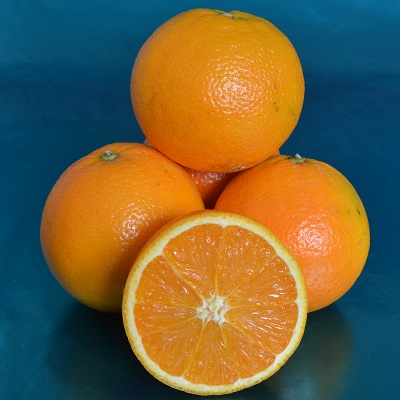Every month of the year has a group of fruit that really comes into its own, and in January it is citrus, closely followed by grapes.
The citrus is from the second half of the Mediterranean season with the tasty late season mandarins and the start of the best oranges money can buy. These are varieties with depth, having benefited from a long growing season that enhances flavour as well as sweetness.
Grapes are mainly from South Africa, Peru and Chile, and, similarly, are represented by fruit from the later growing areas with a wider choice of flavour-packed new varieties.
Not to be out done, however, in this bleakest time of year, there are some wonderful British and European apples, still in peak condition and the start of avocados from Spain and Israel, which makes a change from the southern hemisphere supplies.
In My Fruit Bowl, I Would Have:
- Oranges: Navels from Spain
- Grapes: Sable, Candy Snaps, Candy Dreams, Sweet Celebration, Sugar Crisp, Sweet Globe, Vitoria
- Raspberries
- Apples: Smitten, Envy, Kanzi, Rubens
- Pears: Comice, Concorde
- Lychee: Beautiful Mauritius from Southern Africa
- Avocado: Fuerte and Pinkerton from Spain and Israel
APPLE Update:
Apple quality continues to be excellent with a good choice from UK and European growers. Aside from the usual standard range in all stores (Braeburn, Cox, Gala, Jazz, Pink Lady, etc), it is often possible to find some of the newer or more specialised varieties with a bit of searching. Large superstores of the main supermarkets, and M&S and Waitrose, are the best hunting grounds.
M&S usually has Envy, Smitten, Egremont Russett and Kissabel, and Waitrose often stocks Envy, Smitten, Suffolk Pink, Crimson Crisp, Winter Wonder and Opal. The two retailers have the widest selection, while the other retailers usually have something interesting to try, often in premium brands, or surprisingly, in the value brand packs. For example, Rubens seen recently in Tesco Rosedene pack: a lovely variety. Look out for Kanzi, Junami, Honeycrisp and Cameo, among others. These are all worth trying.
APRICOT Update:
Apricots are plentiful from South Africa and should be of a decent eating quality, if allowed to ripen in your fruit bowl.
AVOCADO Update:
Hass from Spain and Israel is starting to dominate sales as their season becomes predominant, though stocks of later-season fruit from Columbia, Mexico, Chile, etc, will continue. Fuerte and Pinkerton, green-skin varieties, will become more readily available, also from Spain and Israel (often in Tesco and Waitrose).
BLACKBERRY Update:
Good quality blackberries are easily found, though are not necessarily cheap, having come from far afield. South Africa is often a source of the large-berried, sweet Driscoll Victoria, while the more traditionally tangy types, Tupi and Ark45, are from Mexico and Guatemala.
BLUEBERRY Update:
Blueberries are entering mid to late season from Peru and Chile and late to end of season from South Africa, all of which will start to challenge retailers on quality. Watch-out for softness and don’t keep this fruit longer than 2-3 days in the fridge. More and more fruit will arrive from Morocco in January: the better, fresher choice, particularly as much of the production is of the newer varieties.
CHERRY Update:
Cherries quality should continue to be reliable from Chile and Argentina.
FIG Update:
Most stores that sell figs are using Toro Sentado from Peru, which is a good variety and should be satisfactory for eating fresh. Some stores sell Autumn Honey from Israel, which may not have quite the same depth of flavour.
GRAPE Update:
January grapes are generally very good with the new Namibian and South African fruit, and good stocks still available from Peru. Choice of variety becomes more complex:
Red grapes: These are dominated by Crimson and Flame, which are good, crisp, sweet grapes, but lacking in much flavour. Expect to see a plethora of other red varieties on sale as the month progresses, with Sweet Celebration and Jack’s Salute among the best; and Sweet Mayabelle and Candy Snaps offering lovely flavour.
Black grapes: Sweet Favors, Candy Dreams, Sable and Vitoria (from Brazil) are the ‘flavour’ grapes to buy, while the cheaper options will be Midnight Beauty and Melody, the latter being particularly good from South Africa.
Green grapes: The candy floss variety, Cotton Candy will be quite easy to find, and it is well worth finding Sweet Globe and Sugar Crisp as excellent crisp, plump varieties. There will be large volumes of Prime, Early Sweet and Arra 15 available as the standard, slightly underwhelming, offer, with Sugraone and Thompson adding to the choice of similar varieties.
GRAPEFRUIT & POMELO Update:
White Marsh Seedless and Sunrise (aka Star Ruby) from Israel, and the sublime Florida Pink, are the best grapefruit on sale due to their growing conditions. In many stores, the red grapefruit is Star Ruby from Turkey or Spain and is slightly more bitter than the Israeli equivalent, though equally flavoursome.
Chinese Pomelo is easily available in most larger stores, though pomelo from Thailand is more flavoursome and satisfying: possibly available in Asian supermarkets.
KIWI Update:
All green Hayward kiwifruit on sale are from Italy. The sweeter yellow kiwifruit are mostly Dori, Sungold or Jintao, also from Italy.
LEMON Update:
All lemons sold in supermarkets are variety Primofiori from Spain, a good juicy variety, if not a bit seedy.
LYCHEE Update:
Lychee from South Africa continues on sale in early January: such a wonderful, luxurious fruit.
MANDARIN Update:
For mandarins, January is a story of gradual shift to late season varieties. Clemenules, the mainstay of the Christmas market will lose its acids and therefore its taste definition and will be replaced by Nadorcott and Tangold. These are excellent varieties with a great depth of flavour, though may be a little acidic in their first weeks on sale. The excellent Clemenvilla continues but will soon be replaced as a tangerine by Orri, another wonderful variety. Nour, mainly from Morocco, is another late-season clementine that will be on sale: very tasty.
MANGO Update:
January mangoes are pretty uninspiring on the UK market, being primarily Brazilian Keitt, Kent and Palmer, which are rarely the tastiest varieties, though Palmer is the more flavoursome of the three varieties. These will gradually give way to Kent from Peru, which, particularly by March, is actually quite a good example of a much-maligned variety.
MELON Update:
January melons are all from Brazil with Ivory Gaya (in Tesco aka Sweet Snowball) and Piel de Sapo being the most interesting and consistently sweet. Brazilian melons have improved over the past few years as new varieties become available, so even Honeydew, Canteloupe and Galia are offering some sweetness.
ORANGE Update:
Of all the year, January and February offer-up the best oranges. These are from Spain, Morocco, Egypt and Sicily and are mainly the late season variants of Navel oranges (Navelate, Washington Navel, Powell, etc). They are seedless, sweet, juicy and luscious and are not to be missed. The early Navelina variant will be finishing as its acids drop in early January.
Not only are the Navels wonderful at this time of year, but blood oranges from Sicily, particularly Tarocco, are even more alluring with a fleshy, juicy softness that is unmatched. Other blood oranges such as Moro and Sanguinelli will also be on sale, but don’t quite match the excellence of Tarocco.
Salustiana is another variety worth noting as a great orange for juicing. Be a bit careful in supermarkets where they don’t distinguish the various varieties with packaging: always look for the variety name on the label.
From Spain, it is Seville orange season (often sold in Morrisons and Waitrose), so it is time to get the preserving pan out for the best marmalade available – homemade: a simple and satisfying task. Suggested recipe: from The Wednesday Chef/Nigel Slater.
PEACH & NECTARINE Update:
All peaches and nectarines are from South Africa and the season is still strong. Eating quality can be excellent, but the cheaper fruit is often disappointing: ripe and ready to eat options are more reliable.
PEAR Update:
The choice of pears in January, all from UK and Europe, starts to reduce in many stores. The choice is often no more than Rocha and Conference, which can both be lovely, but the latter is often quite bland. Comice (and Sweet Sensation, the blushed version) are probably the most flavoursome pears on sale but will start to disappear towards February. Otherwise, Waitrose and M&S usually have some alternative varieties, and Asda and Lidl will continue with Italy’s favourite pear, Abaté Fétèl.
PERSIMMON Update:
Spanish persimmon, Rojo Brilliante, continues to be available in all stores: a very sweet and tasty fruit. Watch out for the skin colour though, as this is stored fruit on sale and some with pale orange, even yellow, skins can be sneaked in to the packs. These will not be good to eat and will not ripen, so only buy the deeper orange samples.
PLUM Update:
January is good for South African plums, as the early varieties are gone to be replaced with mid-season fruit and some improved varieties: Ruby Sun is a good example.
Cheap plums in punnets are the least reliable and will need to be left in your fruit bowl to soften before they have any chance of satisfying. As with peaches and nectarines, the ripe and ready packs are more reliable and often contain the better varieties.
RASPBERRY Update:
Good quality raspberries are on sale in all stores from South Africa, Kenya, Morocco, Portugal and Spain.
SATSUMA Update:
The main varieties of satsumas are all finished by January. However, small volumes of late varieties such as Bela Bela are available here and there (e.g. M&S, Tesco). These are very satisfying as they have a good depth of flavour. Later in January, a variety called Queen will start to arrive from Spain (often in Morrisons and Waitrose). This is a lovely fruit, easy to peel and sweet, though quite unlike a standard satsuma.
STRAWBERRY Update:
Crunchy strawberries from Egypt, Morocco and Jordan are the choice in January: rarely exciting as a choice for fresh eating.
©Good Fruit Guide 2024. Recommendations on fruit varieties and types with the very best taste are personal to the editor of Good Fruit Guide, and do not attempt to be exhaustive or supported by verifiable consumer research. The highlighting of fruit with the very best taste in the opinion of the editor is not intended as a judgement on the taste of varieties and types of fruit not mentioned.

